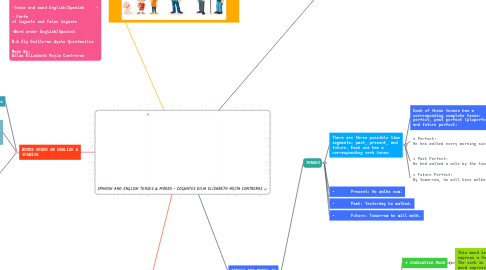
1. Los tiempos verbales son patrones gramaticales de conjugación de verbos que se utilizan para indicar el tiempo de una acción o situación.
1.1. Los verbos se conjugan en tres personas singulares y en tres plurales, y como la terminación del verbo indica la persona a la que pertenece, no siempre es necesario usarla para saber de quien se habla o a que se refiere el enunciado.
1.2. CARÁTULA: Course: Translation and Interpretation Conceptual Map Topics: -Tense and mood English/Spanish - Perfe ct Cognate and False Cognate -Word order English/Spanish B.A Ely Guillermo Ayala Quintanilla Made By: Dilia Elizabeth Mejía Contreras
2. COGNATES & FALSE CONGNATES
2.1. PERFECT COGNATES
2.1.1. Words that are spelled the same and have the same meaning.
2.1.2. Metro - Metro Hospital - Hospital Idea - Idea Escape - Escape Lava - Lava Sociable - Sociable
2.2. FALSE COGNATES
2.2.1. Pairs of words that seem to be cognates because of similar sounds and meaning, but have different etymologies
2.2.2. Actually - De hecho Pie - Pay Carpet - Alfombra Rope - Cuerda Exit - Salida Grape - Uva
2.3. EXAMPLES
2.3.1. Grape — grapa English word: Grape Spanish translation: Uva This grape is very sweet. Esta uva está muy dulce. Spanish word: Grapa English translation: Staple ¿Tienes grapas? Do you have staples?
2.3.1.1. Success — suceso English word: Success Spanish translation: Éxito My first novel was a great success. Mi primera novela fue un gran éxito. Spanish word: Suceso English translation: Event / incident Fue un suceso extraordinario. It was an extraordinary incident.
2.3.1.1.1. Support — soportar English word: Support Spanish translation: Mantener / apoyar You have all my support. Tienes todo mi apoyo. Spanish word: Soportar English translation: To put up with Estoy cansado de soportar las bromas de mi hermano. I’m tired of putting up with my brother’s jokes.
3. WORDS ORDER UN ENGLISH & SPANISH
3.1. Word order in English is
3.1.1. Subject: Typically a noun or pronoun—the person, place or thing.
3.1.2. Verb: The action or state of being.
3.1.2.1. THE WORD ORDER CAN BE SHOW IN 3 PATTERNS:
3.1.2.1.1. NORMAL WORD ORDER
3.1.2.1.2. INVERTED
3.1.2.1.3. WORD ORDER OF DIRECT AND INDIRECT OBJECT
3.1.3. Object: The word or group of words influenced by the verb.
3.2. Word order refers to the way words are arranged in a sentence. The standard word order in English is:
3.3. ORDEN DE LAS PALABRAS EN ESPAÑOL
3.3.1. El orden de palabras constituye uno de los temas más debatidos en los estudios lingüísticos. Tradicionalmente se ha aceptado que la colocación de los elementos en español responde a la secuencia sujeto + verbo + objeto + complementos, orden que difiere del latín clásico.
3.3.1.1. HAY 2 TIPOS PRINCIPALES DE ORDEN
3.3.1.1.1. Orden natural: Sujeto-Verbo-Objeto-Complementos adverbiales
3.3.1.1.2. Ejemplo: Los poetas buscan a las musas en el cielo.
3.3.1.1.3. Orden invertido: Complementos adverbiales-Sujeto-Verbo- Objeto
3.3.1.1.4. Ejemplo: En el cielo, los poetas buscan a las musas.
3.3.1.2. ORDEN SINTÁCTICO
3.3.1.2.1. En el sistema de la lengua española, la construcción de una oración no está sometida a reglas rígidas. No obstante, el orden lógico (sintagma nominal sujeto y sintagma verbal) determina la ubicación de los componentes de una oración.
3.3.1.2.2. 1ro. el sujeto 2do. el verbo 3ro. atributo o complementos: a) directo, b) indirecto c) circunstancial
3.3.1.2.3. ¿CUANDO ES ALTERADO EL ORDEN SINTÁCTICO?
4. TENSES AND MOODS IN ENGLISH
4.1. TENSES
4.1.1. There are three possible time segments: past, present, and future. Each one has a corresponding verb tense.
4.1.1.1. Each of these tenses has a corresponding complete tense: perfect, past perfect (pluperfect), and future perfect:
4.1.1.2. * Perfect: He has walked every morning since Monday.
4.1.1.2.1. Each of these tenses has a continuous or progressive form:
4.1.1.3. * Past Perfect: He had walked a mile by the time we joined him.
4.1.1.4. * Future Perfect: By tomorrow, he will have walked twenty miles.
4.1.2. • Present: He walks now.
4.1.3. • Past: Yesterday he walked.
4.1.4. • Future: Tomorrow he will walk.
4.2. MOODS
4.2.1. Each verb also has a mood that tells us how the action is viewed or perceived by the speaker. There are three moods in English:
4.2.1.1. * Indicative Mood
4.2.1.1.1. This mood is used to express a fact statement. The verb in the indicative mood expresses an action as a statement of fact.
4.2.1.2. * Imperative Mood
4.2.1.2.1. This mood is used to express a command or a request statement. The tone of the sentence is a direct command, not a mild suggestion.
4.2.1.3. * Interrogative Mood
4.2.1.3.1. This mood is used to express a sense of uncertainty by asking a question. The question contains an auxiliary verb (helping verb) and then a main verb.
4.2.1.4. * Conditional Mood
4.2.1.4.1. This mood is used to express a condition statement. The sentence contains an auxiliary verb (helping verb) that supports a main verb.
4.2.1.5. * Subjunctive Mood
4.2.1.5.1. This mood is used to express a wish, doubt, demand, or a hypothetical situation. The verb in the subjunctive mood always changes.
4.2.2. - Imperative
4.2.3. – Indicative
4.2.4. - Subjunctive.
5. TENSES AND MOODS IN SPANISH
5.1. El tiempo verbal es una categoría que permite formas de conjugación que responden a una determinada situación temporal.
5.1.1. SIMPLES
5.1.1.1. El tiempo simple se compone de una voz, correspondiente al verbo que se conjuga:
5.1.1.1.1. Ej. Ella ama cantar.
5.1.2. COMPUESTOS
5.1.2.1. "Perfectos"
5.1.2.1.1. Los tiempos compuestos se forman con el tiempo correspondiente del verbo haber (verbo auxiliar) y el participio del verbo que se conjuga.
5.1.2.2. "Imperfectos"
5.2. MODOS
5.2.1. Los Modos verbales son las diferentes formas en que se puede expresar la acción de un verbo. En el español, hay tres modos verbales principales:
5.2.1.1. INDICATIVO
5.2.1.2. SUBJUNTIVO
5.2.1.2.1. El modo verbal es uno de los accidentes del verbo e indica una determinada posición del hablante respecto de lo que dice.
5.2.1.3. IMPERATIVO
